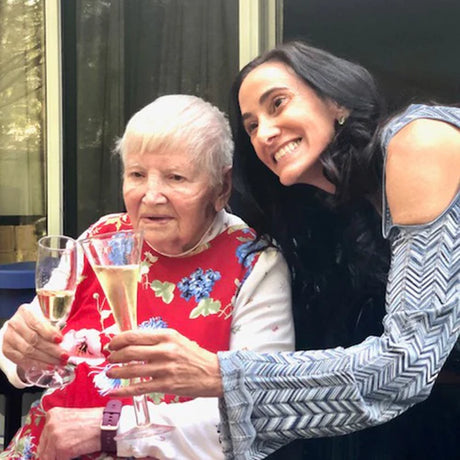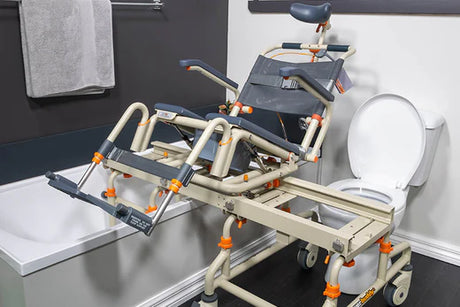The Showerbuddy range is very popular within the elderly community, with options that are great for travelling, and models fit for personal bathroom use. Our shower transfer models are designed for the entire spectrum of mobility impairment, from individuals who can largely move themselves around but benefit from some weight support, to those who can bathe themselves but require transfer assistance, and finally those who’ve lost significant mobility and require assistance from another carer.
So how do families ensure they protect elderly loved ones’ dignity in the bathroom? This article provides some suggestions based on the thousands of elderly Showerbuddy users we’ve engaged with in our community.
Introducing help in the bathroom gradually

In the bathroom, simply starting out by moving all items within reach and ensuring that there are sufficient anti-slip measures in place would be a good start. Some elderly people opt for a raised toilet seat as one of the first mobility items in the bathroom. This will help the difficulty of bending to sit, and the need for core strength to get off a low toilet seat.
It’s not just equipment that may be part of an elderly person’s long term bathroom mobility care. Sometimes a family member or outside carer will be needed to help conduct the day’s activities. Your doctor or occupational therapist may suggest some lighter care to start with if the level of mobility allows for it.
Keeping communication high
Communication provides a number of functions when it comes to bathroom mobility:
- Ensures that the individual is comfortable and happy throughout the process of using the shower, bath or toilet.
- Helps to refine the bathroom care plan as feedback is gained in real time and fed back to an OT.
- Identifies any aspect of the bathroom experience that is particularly difficult.
- Allows for the best equipment solution to be tested and reviewed before settling on an ongoing solution (i.e. finding out how the elderly user felt about using that equipment during a trial).
- Gives the individual more control over what happens in the bathroom each day – if they want to switch the order of things around, or need an adjustment of body position, they can work with whoever is providing assistance.
If you’re unsure about how to approach communicating more effectively, do speak with your loved one’s doctor and the occupational therapist; they’re well experienced in these dynamics and can provide guidance for you both.
Consider external home care support
Dignity in the bathroom for some elderly people means not putting the pressure on their partner to help with anything – be it lifting, cleaning or bathing help. Even in situations in which a partner or adult child is happy to help, it may be harder to enjoy the bathroom experience if a loved one is struggling to provide that support consistently. Professional home care is a wonderful service to engage with, and helps to compartmentalise daily personal routines with family relationships.
Sometimes a combination of the two is what works best; set days or times of day where a home carer comes in for support, offering family respite, and other times of the week where family members help out. This is a popular choice in many countries where home care is funded partially or costs, making full time care uneconomical.
Ultimately home care can help dignity in the bathroom because the nature of the relationship with a home carer is that of a set of tasks and jobs that both parties understand. An outside professional may take some time to settle into a comfortable routine with their client, but once this has settled in, it can be an excellent resource for elderly people with mobility impairments.
Combine solo activity with assistance
Mobility impairment doesn’t preclude independence entirely. This is important for families to understand so that they don’t ‘over-correct’ and remove control from their elderly loved one’s lives. In the bathroom, there may be a number of activities that can be executed alone – brushing teeth, drying off hair, applying body wash or even bathing oneself entirely (with help nearby if needed). An occupational therapist’s job is to help plan these daily functions in a way that makes their client the most comfortable. They will be able to provide a good plan to provide the support that’s needed for the individual’s safety, whilst still giving them the licence to feel in control.
This combination of help and solo activity in the bathroom is another way of gradually transitioning an elderly individual away from full independence to assisted mobility. Some may have degrading personal mobility that over time means the definition of independence changes somewhat (such as being able to enjoy a period of showering alone vs. actively bathing themselves).
Assistive Equipment
Use good quality assistive equipment for the bathroom
The Showerbuddy range is designed with this front of mind. Combined with the range of accessories, Showerbuddy can play a vital role in unlocking more independence for elderly people experiencing mobility challenges. It will also evolve with the user, with optional add-ons that provide more support as needed.
Further reading
Further reading on the topic
Enjoyed this article? You may be interested in these resources online:
- Toileting concerns with aging in place – Seniors Matter
- Providing Support with Personal Care While Protecting a Senior’s Dignity – Five Star Senior Living
- Why Is It Essential for Older Adults to Preserve Their Dignity? – Home Care Assistance Edmonton
























![Toilet Training A Young Child With Mobility Challenges [And How A Shower Chair Can Help]](http://shower-buddy.com/cdn/shop/articles/toilet-training-disabled-child_520x500_a90e5234-d372-435d-aa56-8da15dd3836c.webp?v=1722557239&width=460)


























